Illinois Crop Update – June 13, 2025
Emily Hansen – Commercial Agriculture Educator
LaSalle/Putnam County
Soil Conditions: Near Normal
Fields in LaSalle County have dried out a bit over the last week, with only minimal rainfall over the weekend. At the IVCC + Extension Research and Demonstration Plots corn is nearing V5 and soy V1-2. Other fields scouted in LaSalle County have V6 corn and V2-3 soybeans. One soybean field that was scouted showed signs of root rot, potentially Phytophthora.
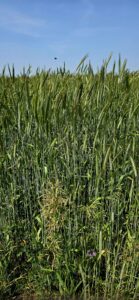
Russ Higgins – Commercial Agriculture Educator
Grundy County
Soil Conditions: Near Normal
Areas within the NE region are starting to dry but potential precipitation is forecast. Favorable higher daytime temperatures are helping both corn and soy, particularly no-till soy that had been lagging. Post herbicide applications and nitrogen sidedress operations continue. Several edge of field issues reported this week, including likely deer feeding on V6 corn and Canada thistle encroaching on soy field edges. Options are limited with deer feeding at this stage of the growing season, we can hope their diet shifts to something besides corn. The perennial Canada thistle can be a challenge to control in a crop setting. The weed can spread vegetatively by rhizomes and windblown seed. The best growing season time to treat Canada thistle with a foliar applied herbicide which can move through the plant (systemic) is normally in June after the first flower buds are formed and before the first flowers open. One hundred percent control often requires multiple timed applications including a fall application.
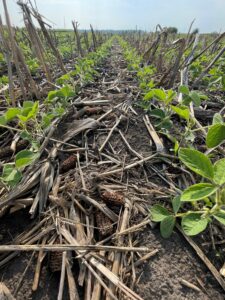
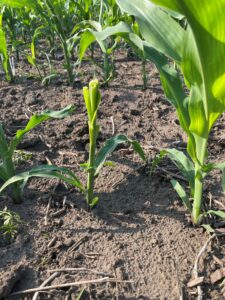
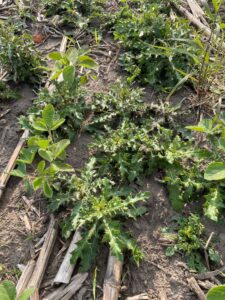
Meagan Diss – Commercial Agriculture Specialist
Warren County
Soil Conditions: Near Normal
The recent rain systems that have moved through much of West Central Illinois have helped to replenish our soil moisture. Soybeans are showing to be mainly in the V3-V5 stage and corn is between V2-V6 with the differences largely being planting date. Main field activities are post emergence applications. We are seeing some weed pressure in the region, mainly waterhemp and giant ragweed. We have seen some replants across the region but largely the fields are looking good. We are on-par, or close to, with 2020-2024 average crop progress and conditions. Looking at the upcoming forecast, we should have mainly dry conditions until this weekend and into next week which should allow field work to continue and crops to progress.
Talon Becker – Commercial Agriculture Specialist
Ford County
Soil Conditions: Mildly Wet (soil is wetter than normal, local vegetation is healthy)
I traveled north to Ford County for my crop survey on Monday (06/09) of this week, and there was a bit of variability across the county in both growth stage and stand health. That variability was driven largely by soil moisture, with saturated soils and localized ponding in low areas and headlands of fields in some parts of the county. Subsequently, these fields currently have uneven crop growth and canopy color, and in some cases, areas that will require a replant. However, most fields I saw during my survey appeared healthy, overall. Corn ranged in maturity from V2/V3 up to V7/V8. Similarly, soybean fields ranged from VE (a couple fields) to V3/V4. The few wheat fields I came across were moving into the ripening stage (Feekes 11.1), with grain heads turning to a golden amber color and kernel starches turning to a milky substance.
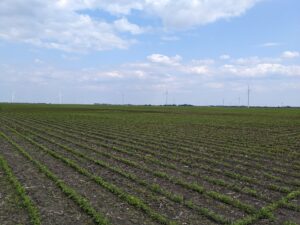
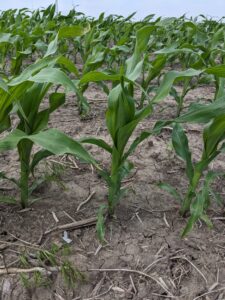
Reagan Tibbs – Commercial Agriculture Educator
Logan County
Soil Conditions: Mildly Wet (soil is wetter than normal, local vegetation is healthy)
Warm temperatures have been very welcome and have helped spur crop development. While there has not been much rain over the last week, there is still plenty of moisture deeper in the soil from previous rains. Some insects are starting to show themselves in corn and soybean fields, but there are no signs of significant damage yet.
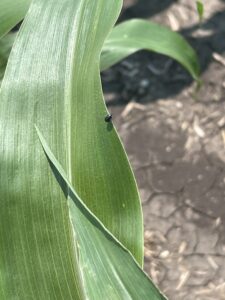
Doug Gucker – Local Food Systems and Small Farms Educator
Dewitt, Macon, and Piatt County
Soil Conditions: Near Normal
The crop conditions across my 3-county area vary from V3 to V7 stage corn, and the soybeans range from unifoliate to blooming. Sidedressing of corn is completed with post-emergent herbicide applications still taking place. The corn and soybean crops look good with few problems.
The few wheat fields in the area are looking good where preventative fungicides were applied earlier. Wheat fields without preventative fungicide applications have numerous diseases present.
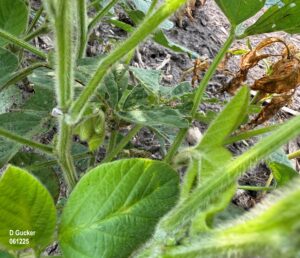
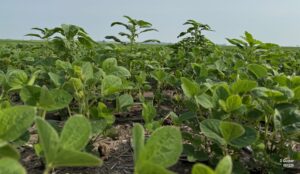

Nick Seiter – Extension Field Crops Entomologist
Champaign County
I’ve received several reports of injury from grape colaspis; in some cases it’s pretty extensive. Scout lighter textured soils and high points in rotated corn (or soybean following soybean), especially in areas that have had trouble in the past. The adults lay eggs in legumes; the partially grown larvae overwinter, then feed on roots of corn, soybean, or most other plants the following year. They resemble tiny white grubs.
Dane Hunter – Commercial Agricultural Specialist
Marion County
Soil Conditions: Moderately Wet (soil is damp, standing water may be present in low areas, water bodies are full)
Since last week’s update most of the region received 2”-5” of rain, so no planting has taken place.
Pictured below is a typical corn field planted on Memorial Day weekend, currently at V3, decent emergence during our relatively dry 3 week span, but some yellowing as a result of waterlogged soils.
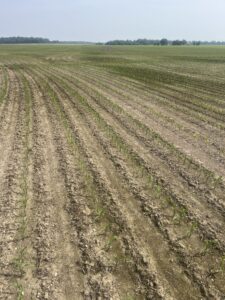
First crop beans are still only partially planted, the typical field that did get in the ground is around VC-V2.

Below is a typical wheat field in Marion county, largely golden, a few greens spots still remaining, grain is in dough stage.






